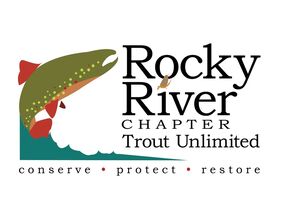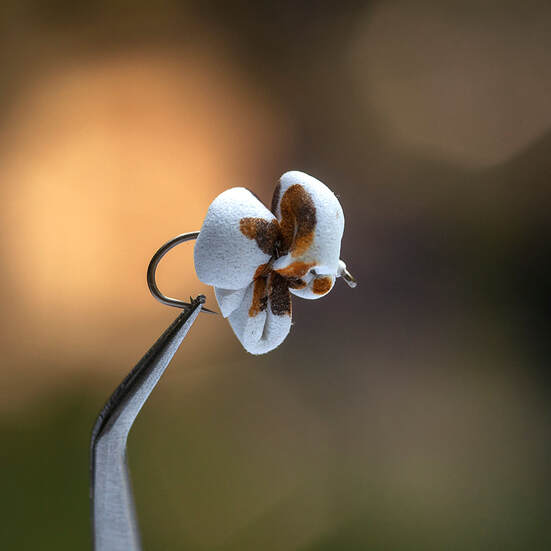Fly of the Month 05.22
Let’s visit the dark side of fly fishing. Paul Rose calls them Carolina bonefish. I grew up calling them doughball fish, mud fish or pond cleaners. The common carp or European carp Cyprinus carpio is a widespread freshwater, mostly water water species of fish that resides on the bottom of our lakes and rivers. They have been introduced domestically to ponds for both aquaculture and for sportfishing contests or derbies using doughballs for bait.
Most anglers have viewed carp as a “trash fish” in terms of fly fishing. Make no mistake, if you hook a carp on a fly, you will have a long time to contemplate the good and the bad of playing a worthy opponent with a fly rod. Carp grow to four feet in length and up to one hundred pounds in weight. The oldest carp on record was thirty-eight years old. Typically, a carp encountered on a fly rod is fifteen to thirty inches weighing up to thirty pounds. Yes, a worthy opponent on a fly rod and a reason to fish a six or eight weight fly rod at times.
The common carp is the number three fish of aquaculture following grass carp Ctenopharyngodon idella and silver carp. Only the common carp and grass carp are typically found in our ponds and reservoirs.
Carp Fly
Given that you want to pursue carp as a target species, what flies are effective for carp? Consider that carp are mostly bottom feeders and scavengers. Consider also that grass carp are primarily plant eaters. Whatever fly pattern is presented, it must draw the attention of the carp without spooking it. I guess this is why Paul Rose calls them Carolina bonefish. Bonefish spook easily and so do carp. One must anticipate the direction a carp is heading and lead the fish with a fly that is ahead of them just enough to be seen but not too close to spook.
There are a number of fly patterns on the market for carp: Carp Breakfast, Rainy’s Carp Tease, Carp Carrot, Barry Reynold’s Carp Fly, Carpolicious, Candy Corn Cluster, Bread Crumb, Rainy’s Mulberry Egg, Medusa and Ashlin’s Hellraisin’ Crawdad. Youtube presents some of these, step by step.
From experience, common carp on Lake Norman respond in the topwater to one of their primary food sources, popcorn. Yes, I said popcorn. People all around the lake feed carp popcorn from their docks. Thus, like tying an imitation of a mulberry or piece of bread or a wad of corn kernels, a piece of popcorn will attract a carp to come up and take such a fly in the surface film - dry fly fishing for common carp! Grass carp are more difficult, but a loose floating slime ball of algae is an ideal meal for a grass carp to surface and take - yep - dry fly fishing for grass carp!
A final thought, are carp edible? Definitely, carp is a traditional part of a Christmas Eve dinner in Central Europe. Hungarian fisherman’s soup or a similar but thicker soup in Czechoslovakia is a specially prepared fish soup of ideally carp alone. In Austria, parts of Germany and Poland, a fried carp is traditional for a Christmas Eve dinner. If served especially on Christmas Eve, then why not at other times.
Fly of the Month 05.22
Alen’s Popcorn
Hook: Dry fly, heavy, wide gap
Size: 6, 8
Thread: 3/0 White
Body: 2 mm white foam strips, tied similar to spun deer hair, but with some foam loops
Marker: Brown and yellow, to create popped kernel look
Alen’s Slimeball
Hook: Dry fly, heavy, wide gap
Size: 6, 8
Thread: 3/0 Green
Body: 2 mm dark green and light green foam strips, tied similar to spun deer hair, but with some foam loops
Marker: Black and brown, to create decayed look
Tom Adams and Alen Baker
Let’s visit the dark side of fly fishing. Paul Rose calls them Carolina bonefish. I grew up calling them doughball fish, mud fish or pond cleaners. The common carp or European carp Cyprinus carpio is a widespread freshwater, mostly water water species of fish that resides on the bottom of our lakes and rivers. They have been introduced domestically to ponds for both aquaculture and for sportfishing contests or derbies using doughballs for bait.
Most anglers have viewed carp as a “trash fish” in terms of fly fishing. Make no mistake, if you hook a carp on a fly, you will have a long time to contemplate the good and the bad of playing a worthy opponent with a fly rod. Carp grow to four feet in length and up to one hundred pounds in weight. The oldest carp on record was thirty-eight years old. Typically, a carp encountered on a fly rod is fifteen to thirty inches weighing up to thirty pounds. Yes, a worthy opponent on a fly rod and a reason to fish a six or eight weight fly rod at times.
The common carp is the number three fish of aquaculture following grass carp Ctenopharyngodon idella and silver carp. Only the common carp and grass carp are typically found in our ponds and reservoirs.
Carp Fly
Given that you want to pursue carp as a target species, what flies are effective for carp? Consider that carp are mostly bottom feeders and scavengers. Consider also that grass carp are primarily plant eaters. Whatever fly pattern is presented, it must draw the attention of the carp without spooking it. I guess this is why Paul Rose calls them Carolina bonefish. Bonefish spook easily and so do carp. One must anticipate the direction a carp is heading and lead the fish with a fly that is ahead of them just enough to be seen but not too close to spook.
There are a number of fly patterns on the market for carp: Carp Breakfast, Rainy’s Carp Tease, Carp Carrot, Barry Reynold’s Carp Fly, Carpolicious, Candy Corn Cluster, Bread Crumb, Rainy’s Mulberry Egg, Medusa and Ashlin’s Hellraisin’ Crawdad. Youtube presents some of these, step by step.
From experience, common carp on Lake Norman respond in the topwater to one of their primary food sources, popcorn. Yes, I said popcorn. People all around the lake feed carp popcorn from their docks. Thus, like tying an imitation of a mulberry or piece of bread or a wad of corn kernels, a piece of popcorn will attract a carp to come up and take such a fly in the surface film - dry fly fishing for common carp! Grass carp are more difficult, but a loose floating slime ball of algae is an ideal meal for a grass carp to surface and take - yep - dry fly fishing for grass carp!
A final thought, are carp edible? Definitely, carp is a traditional part of a Christmas Eve dinner in Central Europe. Hungarian fisherman’s soup or a similar but thicker soup in Czechoslovakia is a specially prepared fish soup of ideally carp alone. In Austria, parts of Germany and Poland, a fried carp is traditional for a Christmas Eve dinner. If served especially on Christmas Eve, then why not at other times.
Fly of the Month 05.22
Alen’s Popcorn
Hook: Dry fly, heavy, wide gap
Size: 6, 8
Thread: 3/0 White
Body: 2 mm white foam strips, tied similar to spun deer hair, but with some foam loops
Marker: Brown and yellow, to create popped kernel look
Alen’s Slimeball
Hook: Dry fly, heavy, wide gap
Size: 6, 8
Thread: 3/0 Green
Body: 2 mm dark green and light green foam strips, tied similar to spun deer hair, but with some foam loops
Marker: Black and brown, to create decayed look
Tom Adams and Alen Baker
Alen’s Popcorn
Recipe :
Hook : Daiichi 1110 or equivalent in size 4,6,8,10,12
Thread : UTC 70 White
Body : White 2mm foam
NOTE: The foam will want to slide around and you may want to apply a drop of cement to the thread at steps of your choosing. Be careful to not cement the foam as it will not float as well. I jusst kept positioning it until I was happy with the appearance. No two kernels look the same anyway.
Recipe :
Hook : Daiichi 1110 or equivalent in size 4,6,8,10,12
Thread : UTC 70 White
Body : White 2mm foam
- Debarb and mount the hook in the vise
- Start thread two eye lengths from the eye and wrap touching turns to the barb returning the thread to the halfway point
- Cut a three inch piece of white foam 1mm or 2mm depending on the hook size and attach it with thread wraps to the top of the hook shank at the central part of the foam strip. Make several turns of thread, one on top of the other, to secure it.
- Fold the back strip of foam forward to make a fold of foam on top of the hook shank and secure at the same spot as the first tie in.
- Repeat this process with the forward part of the foam strip.
- Repeat on the bottom of the fly with a front and back section
- Use a permanent marker to make the popcorn look “popped”. I used two Sharpies, in brown and tan.
NOTE: The foam will want to slide around and you may want to apply a drop of cement to the thread at steps of your choosing. Be careful to not cement the foam as it will not float as well. I jusst kept positioning it until I was happy with the appearance. No two kernels look the same anyway.

